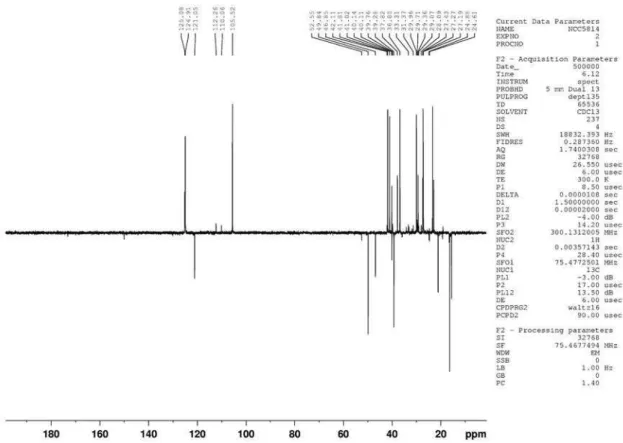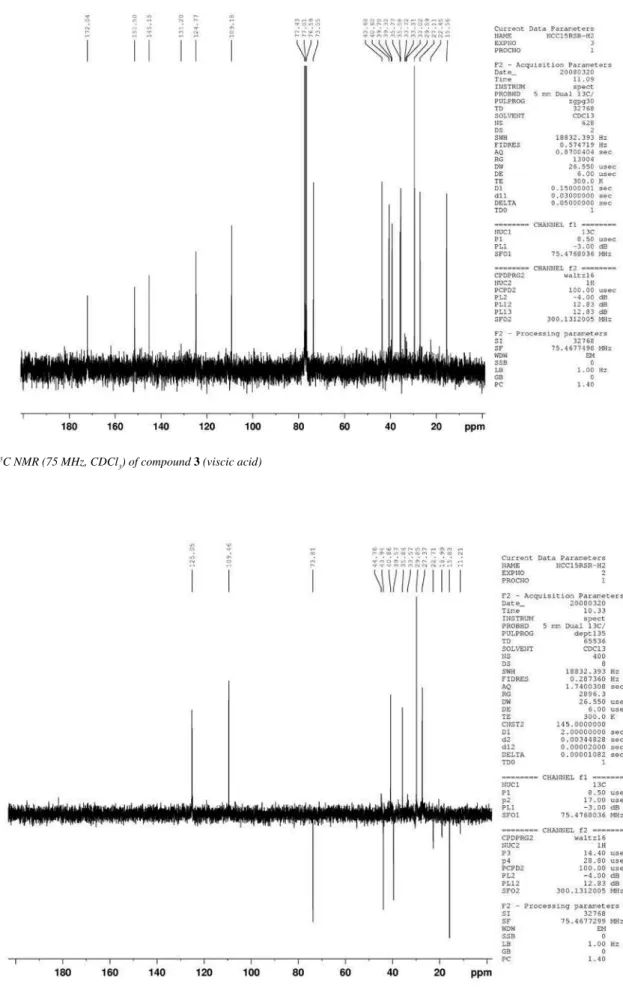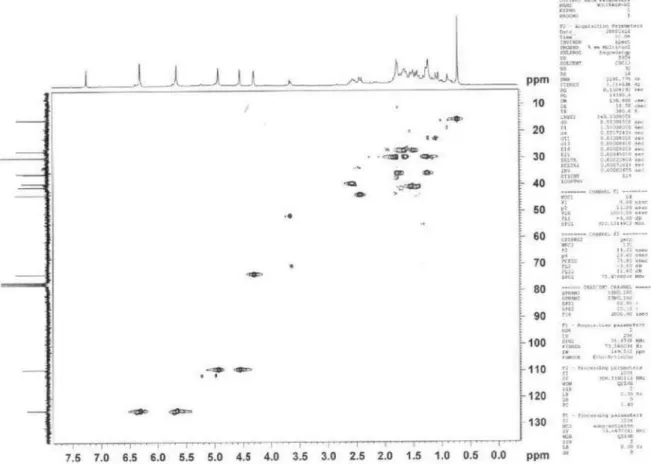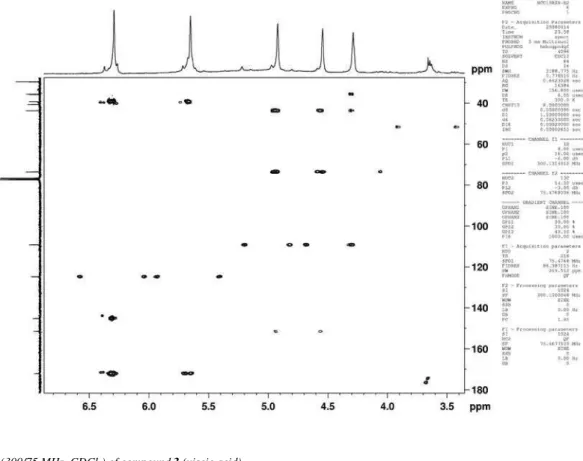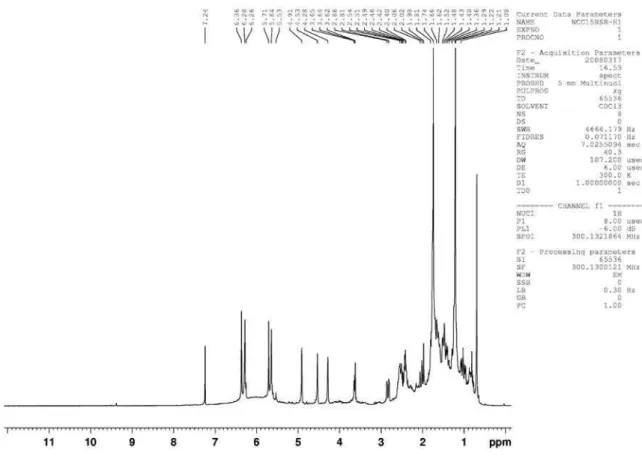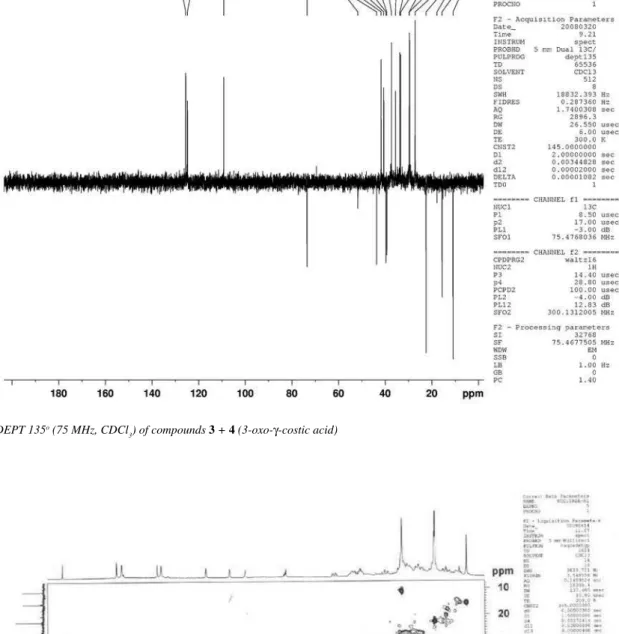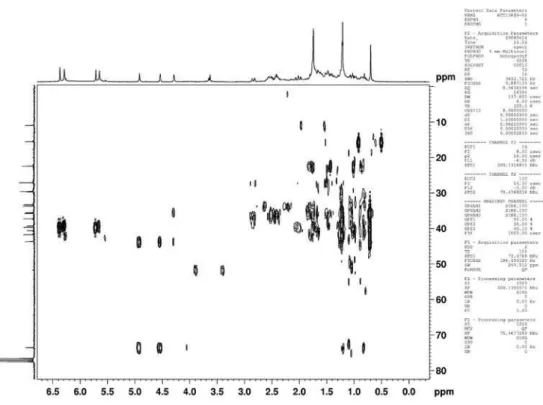Quim. Nova, Vol. 33, No. 8, 1739-1742, 2010
Artigo
*e-mail: frgarcez@nin.ufms.br
EUDESMANE AND REARRANGED EUDESMANE SESQUITERPENES FROM Nectandra cissiflora
Fernanda R. Garcez*, Walmir S. Garcez, Lidilhone Hamerski e Ana Carolina de M. Miranda
Departamento de Química, Centro de Ciências Exatas e Tecnologia, Universidade Federal de Mato Grosso do Sul, Av.Senador Filinto Muller, 1555, 79074-900 Campo Grande - MS,Brasil
Recebido em 12/2/10; aceito em 6/5/10; publicado na web em 24/8/10
Four eudesmane-type sesquiterpenes, costic acid (1), 12-carboxyeudesman-3,11(13)-diene (2), viscic acid (3), 3-oxo-γ-costic acid (4) and two rearranged eudesmane derivatives, 3α-hydroxyisoiphion-11(13)-en-12-oic acid (5) and 5β-hydroxy-4-oxo-11(13)-dehydroiphionan-12-oic acid (6), in addition to (-)-epicatechin, have been isolated from the trunk bark of Nectandra cissilora. This is the irst reported occurrence in the Lauraceae of 3-6. The structures of the isolated compounds have been established on the basis of 1D and 2D NMR spectroscopic techniques. The 13C NMR assignments of 3, 5 and 6 are given here for the irst time, as well as
some corrections to the previously reported chemical shift assignments of 4. Keywords: Nectandra cissilora; Lauraceae; eudesmanes.
INTRODUCTION
Nectandra Rol. ex Rottb. is the second largest genus of the Laura-ceae in the New World, being restricted to the tropical and subtropical Americas, where most of the species occurs between the tropics of Cancer and Capricorn.1 Forty-three species of this genus can be found in Brazil, mostly in the Atlantic Forest and Amazonia.2 On the other hand, Nectandra cissilora Nees is a tree widely distributed in Brazil, where it is popularly known as “canela-fedida”. To date, no phytochemical studies on Nectandra cissilora have been reported, although this genus has been the subject of several chemical investigations, being mostly characterized by the presence of neolignans, lignans and aporphine alkaloids and also by terpenoids found in essential oils.3-5 Addingly, phenylpropanoids, sesquiterpenes and butanolides have also been shown to occur as non-volatile constituents in a few members of Nectandra.4,6,7 Thus, as part of our ongoing study of Brazilian Lauraceae representatives growing in the “Cerrado” of the central-western region of Brazil, we have investigated the chemical composition of the trunk bark of N. cissilora. Herein we report the isolation of four and two rearranged eudesmane-type sesquiterpene acids from this plant, in addition to (-)-epicatechin. EXPERIMENTAL
General experimental procedures
1H and 13C 1D and 2D NMR spectra were recorded at 300 MHz (1H) and 75 MHz (13C) on a Bruker DPX-300 spectrometer. Standard pulse sequences were used for homo - and heteronuclear correlation experiments. Column chromatography procedures were performed on silica gel 70-230 and 230-400 mesh, RP-18 silica gel 230-400 mesh and Sephadex LH-20. Reversed phase semi-preparative HPLC sepa-rations were performed with a Shimadzu LC-6AD pump, using RP-18 and RP-8, 21.6 x 250 mm, 5 µm particle size, Phenomenex Luna column, with a low rate of 10 mL min-1 and monitoring at 210 nm. Plant material
The trunk bark of N. cissilora was collected in Campo Grande, Mato Grosso do Sul, Brazil in August 2005 and identiied by MSc.
F. M. Alves (Departamento de Biologia, Universidade Federal de Mato Grosso do Sul, MS, Brazil). A voucher specimen (No. 11260) has been deposited at CGMS Herbarium (Universidade Federal de Mato Grosso do Sul, Campo Grande, MS, Brazil).
Extraction and isolation of chemical constituents
The air-dried and powdered trunk bark (1.5 kg) of N. cissilora was exhaustively extracted with ethanol at room temperature and the combined extracts were concentrated in vacuo. The residue (115.0 g) was fractionated by CC on silica gel 70-230 mesh eluted succes-sively with stepwise gradients of hexane, CH2Cl2, EtOAc and MeOH to yield 14 fractions (A→O). Fraction C (8.46 g, hexane-CH2Cl2 1:1) was again separated by CC on silica gel 70-230 mesh using a step gradient of increasing polarity: hexane- CH2Cl2-EtOAc-MeOH to give a mixture (104.0 mg) of costic acid (1),8 and eudesma-3,11(13)-dien-12-oic acid (2, minor component, also known as 3-isocostic acid).9 Compound 1 (13.2 mg) was again obtained from fraction D (1.1 g, hexane-CH2Cl2 1:1), after CC on silica gel 230-400 mesh eluted with hexane to pure EtOAc, followed by RP-8 semiprepara-tive HPLC (CH3CN-H2O 8:2). Fraction G (7.04 g, CH2Cl2-EtOAc 8:2) was fractionated on a RP-18 silica gel 230-400 mesh column eluted successively with stepwise gradients of H2O-MeOH (8:2, 6:4, 4:6, 2:8, 1:9, 0.5:9.5) and MeOH to yield seven fractions (G1→G7). Fraction G3 (1.37 g) was rechromatographed on a RP-18 silica gel 230-400 mesh column with a gradient elution of CH3CN-H2O 3:7 to pure CH3CN to furnish ten fractions (G3-1→G3-10). Fraction G3-5 (116.2 mg) afforded an inseparable mixture (13.7 mg) of 5β-hydroxy-4-oxo-11(13)-dehydroiphionan-12-oic acid (5, major compound)10 and 3α-hydroxyisoiphion-11(13)-en-12-oic acid (6)11 after CC on silica gel 230-400 mesh using a gradient system of hexane→EtOAc→MeOH as eluents, followed by CC on Sephadex LH-20 (MeOH). Viscic acid (3, 15.0 mg)12 and a mixture (25.0 mg) of 3 and 3-oxo-γ-costic acid (4, major component)13 were obtained from fraction G3-10 (95.9 mg) after RP-8 semipreparative HPLC (CH3CN-H2O-AcOH 3.5:6.45:0.05). (-)-Epicatechin (7, 8.3 mg) was isolated from fraction N after CC on Sephadex LH-20 (MeOH) fol-lowed by CC on silica gel 230-400 mesh eluted with hexane, EtOAc and MeOH by gradually increasing the polarity gradient.
Viscic acid (3): Oil. [α]D23= - 5.04 (c 0.54, CHCl 3).
H-Garcez et al.
1740 Quim. Nova
15a), 4.54 (br s, H-15b), 4.29 (br s, H-3), 2.55 (m, H-7), 2.41 (br d, J = 11.7, H-5), 1.77 (m, H-2), 1.73 (m, H-1a), 1.63 (m, H-8a), 1.62 (m, H-6a), 1.51 (m, H-9a), 1.45 (m, H-8b), 1.39 (m, H-9b), 1.24 (m, H-6b), 1.23 (m, H-1b), 0.70 (s, H-14). 13C NMR (75 MHz, CDCl
3): δC 172.0 12), 151.5 4), 145.1 11), 124.7 13), 109.2 (C-15), 73.5 (C-3), 43.7 (C-5), 40.6 (C-9), 39.3 (C-7), 35.8 (C-10), 35.6 (C-1), 29.6 (C-2, C-6), 27.1 (C-8), 15.5 (C-14).
3-Oxo-γ-costic acid (4): 1H NMR (300 MHz, CDCl
3) δH: 6.36 (s, H-13a), 5.71 (s, H-13b), 2.83 (br d, J = 13.5 Hz, H- 6a), 2.55 (m, H-7), 2.48 (m, H-2), 2.02 (br t, J = 13.5, H-6b), 1.74 (s, H-15), 1.73 (m, H-9a), 1.70 (m, H-1), 1.68 (m, H-8a), 1.66 (m, H-9b), 1.45 (m, H-8b), 1.21 (s, H-14). 13C NMR (75 MHz, CDCl
3): δC 199.4 (C-3), 171.4 (C-12), 161.4 (C-5), 143.9 (C-11), 129.1 (C-4), 125.4 (C-13), 41.7 9), 39.7 7), 37.3 1), 35.8 10), 33.7 2), 33.3 (C-6), 27.1 (C-8), 22.4 (C-14), 10.9 (C-15).
5β-hydroxy-4-oxo-11(13)-dehydroiphionan-12-oic acid (5): 1H NMR (300 MHz, CD3OD) δH: 5.85 (s, H-13a), 5.28 (s, H-13b), 3.58 (dd, J = 9.8, 7.7, H-3), 2.81 (br t, J = 12.0, H-7), 2.23 (s, H-15), 2.20 (m, H-2a), 1.90 (m, H-2b), 1.85 (m, H-6a), 1.65 (m, H-8a), 1.45 (m, H-6b), 1.40 (m, H-8b), 0.98 (s, H-14). 13C NMR (75 MHz, CD3OD): δC 213.5 (C-4), 175.1 (C-12), 151.8 (C-11), 117.6 (C-13), 84.8 (C-5), 57.3 (C-3), 47.6 (C-10), 38.6* (C-1), 38.4* (C-9), 38.0 (C-7), 37.4 (C-6), 31.6 (C-15), 28.6 (C-8), 23.3 (C-2), 19.1 (C-14); *interchangeable signals.
3α-hydroxyisoiphion-11(13)-en-12-oic acid (6): 1H NMR (300 MHz, CD3OD) δH: 5.82 (s, H-13a), 5.31 (s, H-13b), 4.36 (dd, J = 8.4, 4.3, H-3), 3.20 (m, H-7), 2.25 (m, H-6a), 2.15 (s, H-15), 2.15 (m, H-2a), 1.90 (m, H-2b), 1.75 (m, H-6b), 1.60 (m, H-8a), 1.50 (m, H-8b), 0.98 (s, H-14). 13C NMR (75 MHz, CD
3OD): δC 217.0 (C-4), 175.1 (C-12), 153.1 (C-11), 117.6 (C-13), 80.1 (C-3), 65.9 (C-5), 44.6 (C-10), 38.7* (C-9), 38.3* (C-1), 37.3 (C-7), 33.9 (C-6), 33.0 (C-2), 30.2 (C-15), 27.7 (C-8), 23.0 (C-14); *interchangeable signals. RESULTS AND DISCUSSION
The 1H and 13C NMR spectroscopic data of compound 1, [α] D
23= + 13.0 (c 0.30, CHCl3), were in good agreement with those reported for costic acid, a eudesmane sesquiterpene which was previously isolated from a few members of the Lauraceae, as well as from other plant families .4,7,8,14 The 1H NMR spectrum of 1 was characterized by the presence of the C-14 methyl singlet at δ 0.76, two singlets assigned to the hydrogens of the double bond conjugated to the carboxyl group at C-11 (13) and another two singlets attributed to the exocyclic oleinic hydrogens at C-15. In the 13C NMR spectrum, resonances for C-14, C-11, C-13, C-4 and C-15 were observed at δ 16.4, 145.4, 124.6, 150.6 and 105.5, respectively. Sesquiterpene 1 was also obtained in the present work as an inseparable mixture with compound 2. In the 1H and 13C NMR spectra of this mixture, the signals corresponding to compound 1 were readily discernible and the remaining ones, which were attributed to compound 2, indicated that their structures only differed in the position of the non-conjugated double bond, which was located at C-3 in the skeleton of the latter. This assumption could be inferred by the presence of a vinyl methyl singlet at δH 1.59/δC 21.1 and a signal ascribed to an oleinic hydrogen at δ 5.31, together with the carbon resonances of a trisubstituted double bond at δ 121.0 (CH) and δ 134.7 (C). The spectral data of 2 were in complete agreement with those reported for eudesma-3,11(13)-dien-12-oic acid isolated from Dittrichia graveolens (Asteraceae).9
Comparison of NMR data of 3 with those of 1 revealed that they are closely related. The only difference refers to the presence of a hydroxyl function, on the basis of a broad singlet at δ 4.29 in the 1H NMR spectrum of 3, attributable to the carbinolic hydrogen which correlated in the HSQC spectrum with a signal at δ 73.5. The location
of the hydroxyl group at C-3 in 3 was supported by the long-range correlations observed in the HMBC spectrum between H-3 and the carbons at δ 35.6 (C-1,3J ), 43.7 (C-5, 3J), 109.1 (C-15, 3J) and 151.4 (C-4, 2J). The appearance of H-3 as a broad singlet determined its equatorial position and the resulting α-orientation for the hydroxyl group. Further evidence for this assumption was provided by the upield shifted C-1 and C-5 resonances in 3 (δ 35.6 and 43.7) as com-pared to the chemical shift values of the corresponding carbons in 1 (δ 41.8 and 49.9, respectively), due to the γ-effect of the hydroxyl at C-3. Thus, the structure of 3 was assigned as shown and its 1H NMR data were in good accordance with those reported for 3-α hydroxycostic acid, also known as viscic acid, a sesquiterpene obtained from Dit-trichia viscosa (Asteraceae).12 Unambiguous assignment of 13C NMR data for 3 and not yet published is here presented for the irst time.
Compound 4 was isolated as the main component of an unresolv-able mixture with 3. Comparison of the 1H and 13C NMR signals attributed to 4 with those of 3 showed that the differences in their proton and carbon resonances could be accounted for by the absence of the hydroxyl group, which was replaced by a carbonyl function in 4 and the presence of a C4-C5 double bond in 4 instead of the C4-C15 exocyclic double bond in 3. This proposal was based on the signals attributed to a ketone carbonyl at δ 199.4 and a tetrasubstituted con-jugated double bond at δC 129.1 and 161.4, in addition to a signal ascribed to a vinylic methyl at δH 1.74/δC10.9. The connectivities observed in the HMBC spectrum between the methyl hydrogens H3-15 (δ 1.74) and the carbonyl carbon (δ 199.4) and between H3 -15/ H3-14 (δ 1.21) and the oleinic carbon assigned to C-4 (δ 161.4) conirmed the location of the tetrasubstituted double bond between C-4 and C-5. In the 13C NMR spectrum, the chemical shift of C-15 (δ 10.9) as compared to that of C-15 in compound 2 (δ 21.1) might be due to the γ-effect of the carbonyl at C-3 in 4. The unequivocal assignments of the remaining carbon resonances of 4 were based on the correlations observed in the HSQC and HMBC spectra. Therefore, compound 4 was identiied as 3-oxo-4,11(13)-eudesmadien-12-oic acid, also known as 3-oxo-γ-costic acid, which was previously char-acterized in Varthemia iphionoides13 and also in other members of the Asteraceae. However, the previous chemical shift assignments reported for the carbon resonances C-1, C-8, C-9, C-14 and C-1513 and C-1, C-2, C-6 and C-815 of 3-oxo-γ-costic acid should be corrected and have thus been reassigned in the present work.
Eudesmane and rearranged eudesmane sesquiterpenes from Nectandra cissilora 1741 Vol. 33, No. 8
characteristic signals of an acetyl moiety in the skeleton of 5, namely one methyl singlet at δH 2.23 and a carbonyl carbon signal at δC 213.5. Accordingly, in the HSQC and HMBC spectra the aforementioned methyl singlet showed cross-correlation peaks with the signals at δC 31.6 and 213.5, respectively. Other signals ascribed to 5 in the 1H and 13C NMR spectra of the mixture were those corresponding to another methyl singlet at δH 0.98/δC 19.1 and a quaternary oxygenated carbon at δC 84.8. This information, together with those provided by the DEPT spectrum, suggested the molecular formula C15H22O4 for compound 5, thus indicating a bicarbocyclic skeleton for this ses-quiterpene bearing a ive-membered A ring. The acetyl residue was shown to be linked at C-3, on the basis of connectivities observed in the HSQC and HMBC spectra and so the structure of 5 was related to an iphionane-type sesquiterpene. Thus, the double doublet ascribed to H-3 at δ 3.58 (J = 9.8 and 7.7 Hz), which was shown to be linked to the carbon at δ 57.3 in the HSQC spectrum, showed connectivi-ties in the HMBC spectrum with the signals ascribed to the carbonyl carbon at δC 213.5, the oxygenated quaternary carbon at δC 84.8 and a methylene carbon at δC 23.3. These data were in accordance with the linkage of the acetyl group at C-3 and also with the presence of a hydroxyl function at C-5. This assumption was proved to be correct by the long-range correlation between the methyl hydrogens of the acetyl group and the methylene carbon at δC 23.3, which was thus ascribed to C-2, as well as by the connectivity between the methyl-14 hydrogens at δH 0.98 and C-5 (δC 84.8). Therefore, the structure of 5 was shown to be identical to the iphionane-type sesquiterpene 5β-hydroxy-4-oxo-11(13)-dehydroiphionan-12-oic acid, previously isolated from a species of Asteraceae (Jasonia candicans), but nev-ertheless with no information available on its NMR spectroscopic data.10 However, the 1H NMR data of 5 were in agreement with those of its corresponding methyl ester derivative, which was obtained from another member of the Asteraceae (Ursinia eckloniana)16and thus allowed us to conirm the structure of 5 as shown. The 13C NMR data of 5, which were unequivocally assigned in the present work, are being reported for the irst time.
The remaining signals in the 1H and 13C NMR of the mixture were assigned to its minor component 6, which was also shown to have a rearranged-type sesquiterpene skeleton. Comparison of NMR data of 6 with those of 5 revealed that the only difference was that the hydroxyl group at C-5 and the acetyl moiety at C-3 in 5 changed places with each other in 6. This could be inferred by the presence of a double doublet at δ 4.36 (J = 8.4 and 4.3 Hz), which showed cor-relation with the signal of a carbinolic carbon at δ 80.1 in the HSQC spectrum and was assigned to H-3. In addition, the quaternary carbon resonance at δ 65.9 was attributed to C-5 on the basis of the correlation observed in the HMBC spectrum between this carbon and the methyl hydrogens H-14 at δ 0.98, which in turn showed correlation to C-10 (δ 44.6). Cross-peak correlations were also observed between the acetyl methyl (δ 2.15) and C-5 and C-4 carbonyl (δ 217.0). The 1H NMR data of 6 were in accordance with those previously described for 3α-hydroxyisoiphion-11(13)-en-12-oic acid, which was isolated as its methyl ester derivative from Dittrichia viscosa (Asteraceae).11 Its 13C-NMR assignments were not reported in the literature and so are provided in the present work.
The co-occurrence in N. cissilora of the iphionane- and isoiph-ionane-type sesquiterpenes 5 and 6 and eudesmanes 1-4 reinforces the suggested biogenetic inter-relationship between those relatively small group of naturally occurring rearranged sesquiterpenes and eudesmanes.17 Thus, compound 5, which might have been formed by oxidative cleavage of C-4/C-5 bond of an eudesmane-type ses-quiterpene precursor [eudesma-4,11(13)-diene-12-oic acid] leading to a 4,6-diketo derivative, followed by aldol condensation between C-3 and C-5, is thus being reported for the irst time in the Lauraceae.
Compound 6, which is also being reported for the irst time in the Lauraceae, might have been originated, in a similar fashion as 5, by oxidative cleavage of C3/C-4 bond of 2, followed by aldol condensa-tion between C-3 and C-5 of the dicarbonyl derivative.
CONCLUSION
Although sesquiterpenes have been found in several species of the Lauraceae, mainly as components of leaf essential oils, only three representatives of this class of compounds have been described so far as non-volatile constituents in members of the genus Nectandra, namely 3-isocostic acid and ilicic acid in N. membranacea4 and costic acid in N. grandilora and N. membranacea,4,7 and so the chemotaxo-nomic importance of the sesquiterpenoids obtained from N. cissilora in the present work deserves consideration. Noteworthy is the irst reported occurrence in the Lauraceae of 3-6, sesquiterpenes which were previously found as constituents of species of the Asteraceae. Also worthy of mentioning is that sesquiterpene acids bearing rear-ranged eudesmane skeletons of the iphionane- and isoiphionane-types like those depicted by 5 and 6, respectively, are scarcely distributed in plants. On the other hand, aporphine alkaloids, neolignans and lignans, which represent the major classes of secondary metabolites isolated from members of Nectandra, have not been detected in the specimen of N. cissilora investigated in the present work. SUPPLEMENTARY MATERIAL
1H NMR, 13C NMR, HSQC and HMBC spectra of compounds 1-6 are available free of charge at http://quimicanova.sbq.org.br as a PDF ile.
ACKNOWLEDGMENTS
The authors are grateful to FUNDECT-MS, CPq-PROPP-UFMS and PROAP-CAPES for their inancial support and to CNPq and CAPES for the scholarships awarded. Thanks are also given to MSc. F. M. Alves (Departmento de Biologia, Universidade Federal de Mato Grosso do Sul, MS, Brazil) for his assistance in the identiication of the plant material.
REFERENCES
1. van der Werff, H.; Ann. Missouri Bot. Gard.1991, 78, 377.
2. Baitello, J. B.; Hernandez, F. L.; Moraes, P. L. R.; Esteves, R.; Marcovino, J. R. In Flora Fanerogâmica do Estado de São Paulo; Wanderley, M. G. L.; Shepherd, G. J.; Melhem, T. S.; Giulietti, A. M.; Kirizawa, M., eds.; RiMa/FAPESP: São Paulo, 2003, vol. 3, p. 149. 3. Barrera, C. E. D.; Suarez, L. E. C.; Chem. Pharm. Bull. 2009, 57, 639;
Barbosa Filho, J. M.; Yoshida, M.; Gottlieb, O. R.; Phytochemistry1989, 28, 1991; Carvalho, M. G.; Yoshida, M.; Gottlieb, O. R.; Gottlieb, H. E.; Phytochemistry1987, 26, 265; Castro, O.; Hasbun, C.; Calderon, M.; Fitoterapia 1991, 62, 72; Cherigo, L.; Polanco, V.; Ortega-Barria, E.; Heller, M. V.; Capson, T. L.; Rios, L. C.; Nat. Prod. Res.2005, 19, 373; Silva, A. A.; Albuquerque, S.; Silva, M. L. A. E.; Eberlin, M. N.; Tomazela, D. M.; Bastos, J. K.; J. Nat. Prod.2004, 67, 42.
4. Wu, X.; Vogler, B., Haber; W. A., Setzer, W. N.; Nat. Prod. Comm. 2006, 1, 465.
5. Ciccio, J. F.; Chaverri, C.; Diaz, C.; Quim. Nova2009, 32, 417. 6. Garcez, F. R.; Garcez, W. S.; Hamerski, L.; Miguita, C. H.; Quim. Nova
Garcez et al.
1742 Quim. Nova
7. Moreno, P. R. H.; von Poser, G. L.; Rates, S. M. K.; Yoshida, M.; Gottlieb, O. R.; Souza, I. A.; Henriques, A. T.; Int J. Pharmacog. 1993, 31, 189.
8. Watanabe, Y.; Mihara, R.; Mitsunaga, T.; Yoshimura, T.; J. Wood Sci. 2005, 51, 514.
9. Lanzetta, R.; Lama, G.; Mauriello, G.; Parrilli, M.; Racioppi, R.; Soda-9. Lanzetta, R.; Lama, G.; Mauriello, G.; Parrilli, M.; Racioppi, R.; Soda-no, G.; Phytochemistry1991, 30, 1121.
10. Ahmed, A. A.; Mahmoud, A. A.; Tetrahedron1998, 54, 8141. 11. Rustaiyan A.; Jakupovic J.; Chau-Thi T. V.; Bohlmann F.; Sadjadi A.;
Phytochemistry 1987, 26, 2603.
12. Ceccherelli, P.; Curini, M.; Marcotullio, M. C.; Menghini, A.; Phytoche-mistry 1985, 24, 2987.
13. Al-Dabbas, M. M.; Maher, M.; Hashinaga, F.; Abdelgaleil, S. A. M.; Suganuma, T.; Akiyama, K.; Hayashi, H.; J. Ethnopharmacol.2005, 97, 237.
14. Cheng, W.; Zhu, C.; Xu, W.; Fan, X.; Yang, Y.; Li, Y.; Chen, X.; Wang, W.; Shi, J.; J. Nat. Prod.2009, 72, 2145.
15. Sanz, M. B. K.; Donadel, O.; J.Plant Cell Tissue Organ Cult.2003, 73, 123.
16. Jakupovic, J.; Ganzer, U.; Pritschow, P.; Lehmann, L.; Bohlmann, F.; King, R. M.; Phytochemistry 1992, 31, 863.
Quim. Nova, Vol. 33, No. 8, S1-S13, 2010
Material Suplementar
*e-mail: frgarcez@nin.ufms.br
EUDESMANE AND REARRANGED EUDESMANE SESQUITERPENES FROM Nectandra cissiflora
Fernanda R. Garcez*, Walmir S. Garcez, Lidilhone Hamerski e Ana Carolina de M. Miranda
Departamento de Química, Centro de Ciências Exatas e Tecnologia, Universidade Federal de Mato Grosso do Sul, Av.Senador Filinto Muller, 1555, 79074-900 Campo Grande - MS,Brasil
Figure 1s. 1H NMR (300 MHz, CDCl
Garcez et al.
S2 Quim. Nova
Figure 2s.13C NMR (75 MHz, CDCl
3) of compound 1 (costic acid)
figure 3s. DEPT 135o (75 MHz, CDCl
Eudesmane and rearranged eudesmane sesquiterpenes from Nectandra cissilora S3 Vol. 33, No. 8
Figure 4s.1H NMR (300 MHz, CDCl
3) of compounds 1 + 2 [costic acid and eudesma-3,11 (13)-dien-12-oic acid]
figure 5s.13C NMR (75 MHz, CDCl
Garcez et al.
S4 Quim. Nova
Figure 6s, DEPT 135o (75 MHz, CDCl
3) of compounds 1 + 2 [costic acid and eudesma-3,11 (13)-dien-12-oic acid]
figure 7s.1H NMR (300 MHz, CDCl
Eudesmane and rearranged eudesmane sesquiterpenes from Nectandra cissilora S5 Vol. 33, No. 8
Figure 8s.13C NMR (75 MHz, CDCl
3) of compound 3 (viscic acid)
figure 9s. DEPT 135o (75 MHz, CDCl
Garcez et al.
S6 Quim. Nova
Figure 10s. HSQC (300/75 MHz, CDCl3) of compound 3 (viscic acid)
Eudesmane and rearranged eudesmane sesquiterpenes from Nectandra cissilora S7 Vol. 33, No. 8
Figure 12s. HMBC (300/75 MHz, CDCl3) of compound 3 (viscic acid)
Garcez et al.
S8 Quim. Nova
Figure 14s.1H NMR (300 MHz, CDCl
3) of compounds 3 + 4 (3-oxo-γ-costic acid)
figure 15s.13C NMR (75 MHz, CDCl
Eudesmane and rearranged eudesmane sesquiterpenes from Nectandra cissilora S9 Vol. 33, No. 8
Figure 16s. DEPT 135o (75 MHz, CDCl
3) of compounds 3 + 4 (3-oxo-γ-costic acid)
Garcez et al.
S10 Quim. Nova
Figure 18s. HMBC (300/75 MHz, CDCl3) of compounds 3 + 4 (3-oxo-γ-costic acid)
Eudesmane and rearranged eudesmane sesquiterpenes from Nectandra cissilora S11 Vol. 33, No. 8
Figure 20s.1H NMR (300 MHz, CD
3OD) of compounds 5 (5β-hydroxy-4-oxo-11(13)-dehydroiphionan-12-oic acid) + 6 (3α -hydroxyisoiphion-11(13)-en-12-oic acid)
figure 21s.13C NMR (75 MHz, CD
Garcez et al.
S12 Quim. Nova
Figure 22s. DEPT 135o (75 MHz, CD
3OD) of compounds 5 (5β-hydroxy-4-oxo-11(13)-dehydroiphionan-12-oic acid) + 6 (3α -hydroxyisoiphion-11(13)-en-12-oic acid)
Eudesmane and rearranged eudesmane sesquiterpenes from Nectandra cissilora S13 Vol. 33, No. 8
Figure 24s. HMBC (300/75 MHz, CD3OD) of compounds 5 (5β-hydroxy-4-oxo-11(13)-dehydroiphionan-12-oic acid) + 6 (3α -hydroxyisoiphion-11(13)-en-12-oic acid)
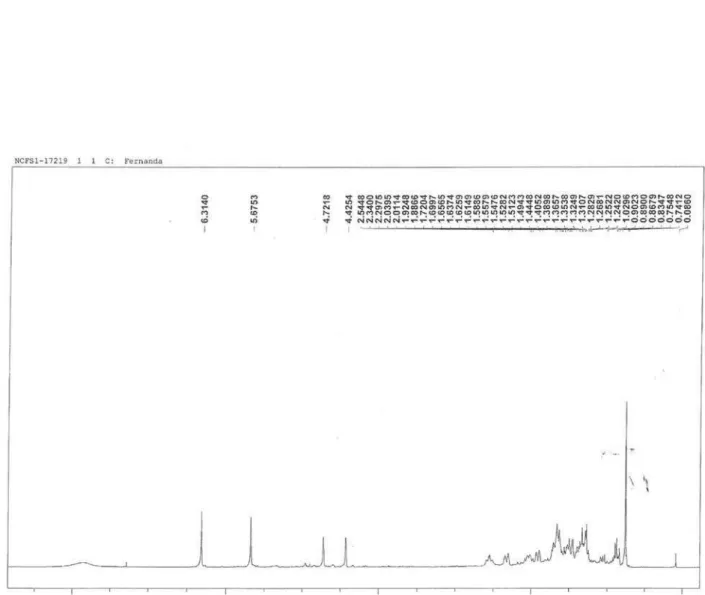
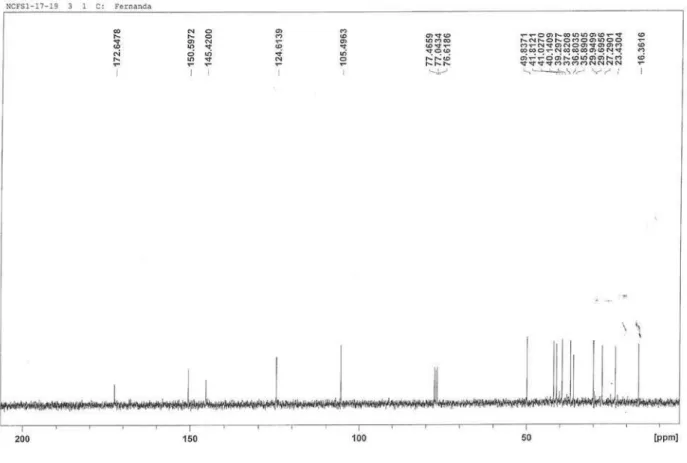
![figure 5s. 13 C NMR (75 MHz, CDCl 3 ) of compounds 1 + 2 [costic acid and eudesma-3,11 (13)-dien-12-oic acid]](https://thumb-eu.123doks.com/thumbv2/123dok_br/18985034.458539/7.892.159.759.663.1090/figure-nmr-mhz-cdcl-compounds-costic-acid-eudesma.webp)
